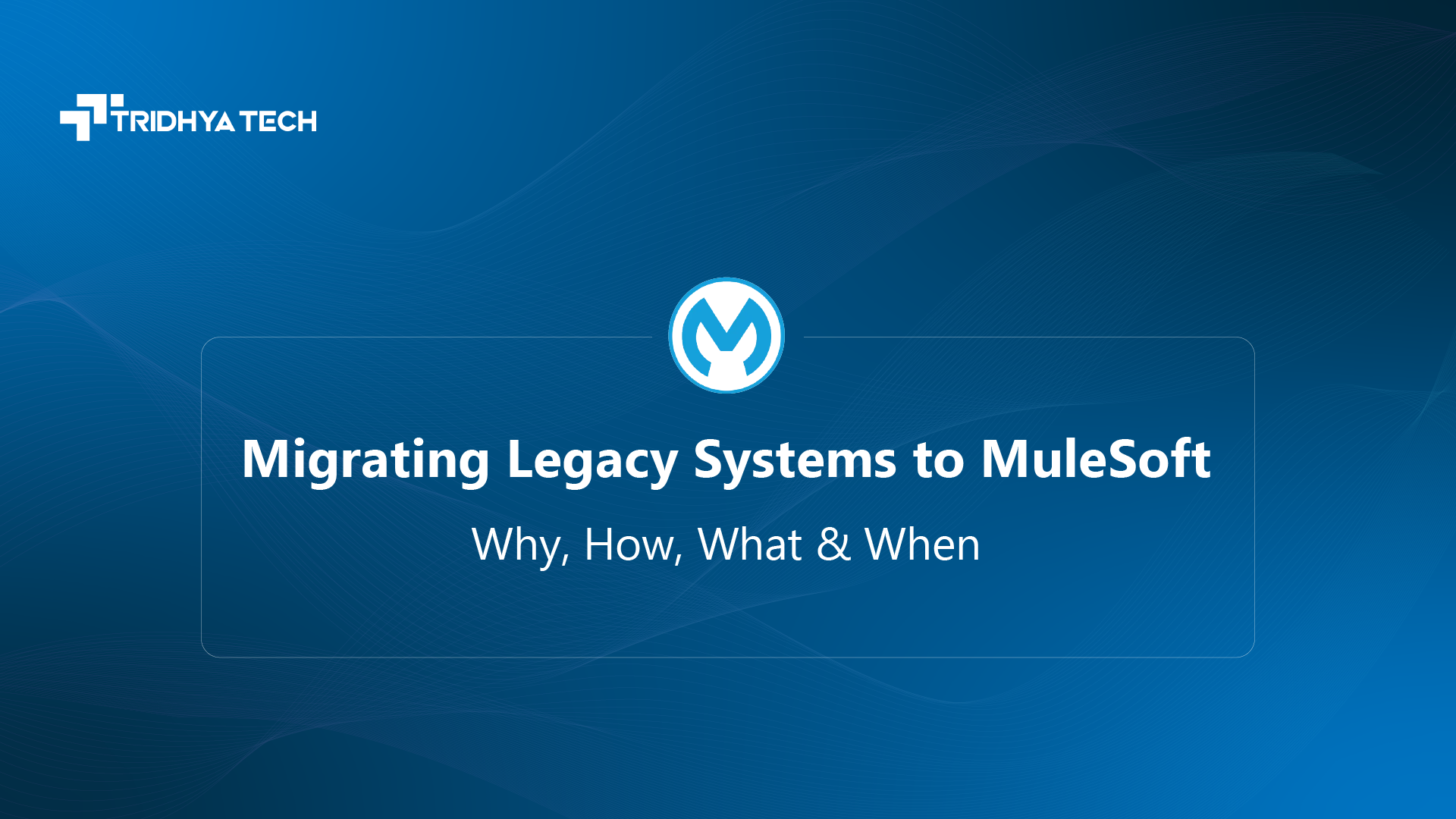MuleSoft
Migrating Legacy Systems to MuleSoft – Why, How, What & When
It’s 2024, and companies are adopting advanced technologies like IoT, AI, Blockchain, and Cloud Computing. However, some companies hesitate to embrace new technologies and innovation because of budgetary constraints and technological hurdles. Legacy systems are one such hurdle.
Companies may incur over $30 million in maintenance and operating costs for a legacy system. Maintaining existing IT infrastructure and investments, including legacy systems, can cost approximately $1.4 trillion annually.
Legacy systems can last for decades, but technology evolves faster than that. Within a few years, legacy systems will become obsolete. Still, companies are not prepared to upgrade them or make new investments. Resistance to change is also another factor.
Legacy systems cost a fortune to maintain and expose companies to security and compliance risks. Businesses using legacy systems in the U.K. lose at least 28,000 pounds annually. MuleSoft development services are an excellent solution to address these problems.
Migrating to MuleSoft allows companies to leverage cutting-edge technologies and take their business to the next level. This blog will focus on the how, when, what, and who of migrating legacy systems to MuleSoft. Without further ado, let’s get started.
Table of Contents
- Introduction
- Why Should Companies Migrate Legacy Systems to MuleSoft?
- 5-Step Process to MuleSoft Migration for Legacy Systems
- Results After Migrating Legacy Systems to MuleSoft
- When Should Companies Migrate Legacy Systems to MuleSoft?
- Final Summary
Why Should Companies Migrate Legacy Systems to MuleSoft?
Migrating legacy systems to MuleSoft can be beneficial for companies. Below are a few reasons why.
1. Improved Integration
MuleSoft’s API-led approach facilitates effective integration between multiple systems, no matter how old the systems or the complexity of the process. API-led connectivity results in faster and more reliable data exchange for enhanced business processes.
2. Greater Scalability
Companies can leverage MuleSoft’s cloud-native architecture to scale their applications and meet the increasing business needs. Robust integrations can handle heavy workloads without compromising performance
3. Business Agility
Thanks to MuleSoft, companies can modernize their legacy systems and adopt innovative technologies to meet increased business demands and customer preferences. MuleSoft also shortens development time, resulting in faster market time for new products and sustaining cut-throat competition.
4. Reduced Costs
With MuleSoft, companies can automate manual and repetitive processes while streamlining workflows. Also, MuleSoft’s pre-built connectors and templates reduce the need to develop custom integrations every time, reducing overall operational costs.
5. Refined Data Quality
Facilitate informed decision-making with MuleSoft’s data transformation capabilities that ensure uniform and accurate data across multiple systems.
5-Step Process to MuleSoft Migration for Legacy Systems
Below is the 5-step process for migrating legacy systems to MuleSoft.
1. Detailed Legacy System Assessment
The first step is to evaluate the organization’s legacy systems, including their functionalities, performance, and integration points, and identify potential challenges (a SWOT analysis).
2. API-Led Connectivity
Next, create a foolproof API strategy to determine the core functionalities of legacy systems and the ones most crucial for integration. Companies must create well-defined, reusable, and secure APIs.
3. Integration Flows
Develop integration flows using MuleSoft’s Anypoint platform. This platform connects legacy systems and other apps, transforms and filters data while automating manual tasks.
4. Testing and Deployment
After developing the integration flows, companies must conduct stringent testing to meet performance and security requirements. After testing, the integrations must be deployed in a real-time environment (on-premises or the cloud).
5. Continuous Monitoring
Monitor the performance of integration flows continuously and resolve issues that arise. MuleSoft’s management tools are ideal for optimizing performance and addressing problems.
Results After Migrating Legacy Systems to MuleSoft
Companies will expect results after the migration process. The results they can expect are as follows:
- Speeds up digital transformation and greater innovation for companies.
- Effective data integration and streamlined processes result in enhanced customer experiences.
- Automated workflows and reduced manual efforts boost productivity and cut costs.
- The combined might of API-led connectivity, Anypoint Platform, Dataweave, and Integration Security ensures robust data governance and security. It improves data quality and safeguards sensitive information.
When Should Companies Migrate Legacy Systems to MuleSoft?
Below are the signs for companies to migrate to MuleSoft.
- Manual processes, point-to-point interactions, and data silos hamper operations.
- Long development cycles and complex integration result in delayed product launches.
- Inconsistent and inaccurate data leads to poor decisions and rising operational costs.
- Obsolete systems become vulnerable to cyber-attacks and data breaches.
Final Summary
Businesses cannot afford to remain stagnant in the present era. They must keep evolving to stay competitive and meet increasing customer expectations. Companies must determine whether and when to migrate their legacy systems to MuleSoft. They must examine the pros and cons while determining the costs. Most importantly, companies don’t have to worry about the ROI with MuleSoft integration.
Reusable APIs help companies save big bucks by reducing the need for connections. Also, quicker deployment eliminates the need for complex implementations. Tridhya Tech’s expert MuleSoft Consulting Services can help your company leverage MuleSoft’s extraordinary features like routers, filters, scopes, transformers, connectors, and others while capitalizing on its simple and robust suite.
Lack of subject matter expertise and documentation, unknown dependencies, and poor quality assurance can be hurdles to MuleSoft migration. Tridhya Tech’s extensive 6+ years of industry experience and a fleet of 600+ technical experts can make your legacy system migration seem like a cakewalk. Call +1 386 597 1231 to schedule a consultation.
Related Blogs
Recent Blogs
-
Future of Mobile Apps in the Car Rental Industry – 2025 and Beyond
-
Why Your Business Needs a Collaboration portal in 2025
-
MuleSoft in Healthcare: Transforming the Patient Management Experience
-
E-Commerce Integrations You Cannot Miss in 2024-25
-
Decode Supplier Management Success with Advanced Vendor Portals



























